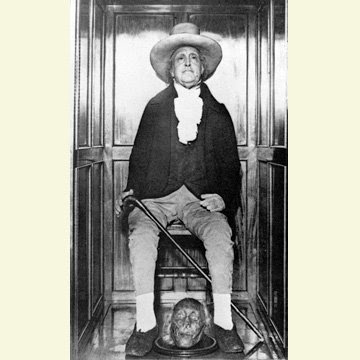
Listen: The father of Utilitarianism had his skeleton preserved and dressed in his favorite suit, in order to preside over meetings after his demise. Bentham did this. Bentham, in many regard the ur-Rational Guy, the philosophical father of our post-modern avatar of Rational Behavior.
But the preservation method for Bentham’s head got screwed up, with monstrous results. It wound up looking like it was carved from meatloaf jerky, so they used a wax head instead, and positioned Jeremy Bentham’s actual severed head on the floor between the philosophy scarecrow’s feet–just because.
They (who? who knows?!) ultimately decided the severed head on the floor was either gruesome or an attractive nuisance, and so decided to store it in a box somewhere and replaced it with a replica, or sometimes nothing. Anyway, in the pic above, that’s Jeremy Bentham’s actual head on the floor, fronting all John the Baptist-post-Salome-style. Here’s a close up of the head–the actual head of an actual famous philosopher who had this done to himself on purpose:
![]()
So those creepy peepers? Bentham carried those around in his pocket for much of his life, so they could wind up in his severed jerky head and attend meetings for all eternity.
This . . . I . . . damn. I guess dude believed this bizarre gesture would somehow maximize humanity’s happiness and reduce suffering, although the mechanism for that escapes me.
In the end, though, I find the idea of those eyes staring at the inside of a dark box even *more* distressing than having them stare out a glass case from between Bentham’s feet. Even though he can’t see us, J.B. is still watching us, and likely finding us wanting. *shudders*
Jeremy Bentham – Wikipedia, the free encyclopedia
On 8 June 1832, two days after his death, invitations were distributed to a select group of friends, and on the following day at 3 p.m., Southwood Smith delivered a lengthy oration over Bentham’s remains in the Webb Street School of Anatomy & Medicine in Southwark, London. The printed oration contains a frontispiece with an engraving of Bentham’s body partly covered by a sheet.[18]
Afterward, the skeleton and head were preserved and stored in a wooden cabinet called the “Auto-icon”, with the skeleton padded out with hay and dressed in Bentham’s clothes. Originally kept by his disciple Thomas Southwood Smith,[19] it was acquired by University College London in 1850. It is normally kept on public display at the end of the South Cloisters in the main building of the college; however, for the 100th and 150th anniversaries of the college, it was brought to the meeting of the College Council, where it was listed as “present but not voting”.[20]
Bentham had intended the Auto-icon to incorporate his actual head, mummified to resemble its appearance in life. However, Southwood Smith’s experimental efforts at mummification, based on practices of the indigenous people of New Zealand and involving placing the head under an air pump over sulphuric acid and simply drawing off the fluids, although technically successful, left the head looking distastefully macabre, with dried and darkened skin stretched tautly over the skull.[18] The Auto-icon was therefore given a wax head, fitted with some of Bentham’s own hair. The real head was displayed in the same case as the Auto-icon for many years, but became the target of repeated student pranks. It is now locked away securely.[21]
(see also: Jeremy Bentham’s Auto-Icon | Atlas Obscura)
